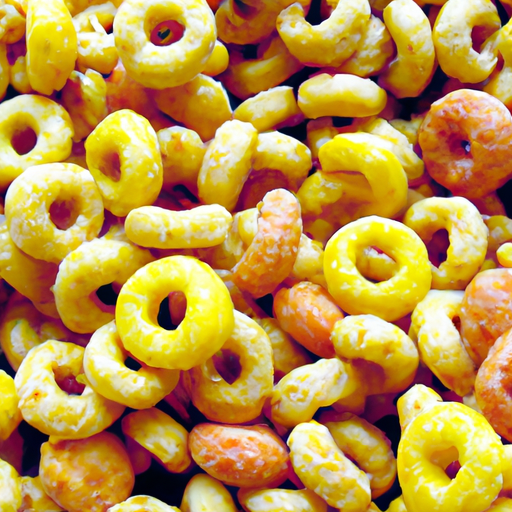The Versatile Delight: Cheerios Oat Cereal
If you’re a cereal lover, chances are you’ve come across the iconic Cheerios oat cereal. This beloved cereal has been a staple breakfast option for decades, delighting both kids and adults alike. But Cheerios isn’t just your average cereal; it boasts a rich history, a unique taste, and a plethora of culinary possibilities. Let’s dive into the world of Cheerios and discover why it has become a pantry essential in households worldwide.
A Cornucopia of Flavor
When it comes to taste, Cheerios oat cereal offers a simple yet satisfying experience. The classic flavor profile features a subtle sweetness with a hint of toasted grain. The oats provide a delightful crunch, making every spoonful a delightful sensation for your taste buds. What sets Cheerios apart from other cereals is its distinct flavor combination that manages to be both comforting and familiar.
Culinary Adventures with Cheerios
Cheerios isn’t just for breakfast – it shines in various culinary creations, adding texture, flavor, and nutrition to a wide range of dishes. Here are some exciting ways to incorporate Cheerios oat cereal into your cooking adventures:
1. Snack Sensation: Trail Mix
Take your snack game to the next level by adding a handful of Cheerios to your favorite trail mix recipe. The combination of crunchy oats, nuts, dried fruits, and chocolate creates a delightful medley of sweet and savory flavors that will keep you energized throughout the day.
2. Coating Crunch: Chicken Breading
Get creative in the kitchen by using crushed Cheerios as a breading for chicken. Simply crush the cereal and mix it with your preferred seasonings, then coat the chicken before frying or baking. The result? A perfectly crispy, flavorful coating that elevates your chicken to a whole new level.
3. Dessert Extravaganza: Yogurt Parfait
Layering Cheerios with yogurt and fresh berries creates a delightful parfait that caters to your sweet tooth. The contrasting textures of creamy yogurt and crunchy cereal make each spoonful a delightful experience, perfect for breakfast or as a refreshing dessert.
Nutritional Valor of Cheerios
Apart from its captivating taste and culinary versatility, Cheerios oat cereal is a commendable choice from a nutritional standpoint. Made with whole grains and heart-healthy oats, it’s a fantastic source of fiber and essential vitamins. The low sugar content makes it an excellent option for those looking for a balanced way to start their day.
The Journey of Cheerios
Believe it or not, Cheerios has an intriguing history. First introduced in 1941, Cheerios quickly gained popularity due to its unique shape, which resembled miniature life preservers. Originally called “Cheerioats,” the name was shortened to “Cheerios” in 1945. Since then, Cheerios has become a breakfast staple in many households, with numerous varieties hitting the market, including Honey Nut Cheerios, Multi Grain Cheerios, and more.
Cheerios oat cereal is more than just a breakfast option – it’s a culinary companion that elevates your dishes while providing a wholesome and delightful experience. Its distinct flavor, versatility in recipes, and nutritional value make it a standout choice for both the cereal aisle and kitchen pantry. So why not embark on a Cheerios adventure and explore the endless possibilities awaiting your creativity?
Origin:
Cheerios oat cereal was introduced by General Mills in 1941. It was initially called “CheeriOats” but later renamed “Cheerios” in 1945.
Common Uses:
Cheerios oat cereal is primarily consumed as a breakfast cereal, often served with milk or yogurt. However, it can also be used in other culinary applications such as in granola bars, trail mixes, and as a topping for desserts.
Nutritional Benefits:
Whole Grains: Cheerios oat cereal is made primarily from whole grain oats, which contribute to its nutritional benefits. Whole grains are a good source of dietary fiber, vitamins, minerals, and antioxidants.
Low in Sugar: Cheerios oat cereal contains minimal added sugar and is often considered a healthier option among breakfast cereals. The plain variety of Cheerios has only 1 gram of sugar per serving.
Cholesterol and Trans Fat Free: Cheerios is a cholesterol-free and trans fat-free food. It can be part of a heart-healthy diet due to its low saturated fat content.
Source of Nutrients: Cheerios oat cereal is a source of various essential nutrients, including iron, calcium, and vitamins such as vitamin B6, folate, and vitamin E.
Unique Properties:
Shape and Texture: Cheerios oat cereal is known for its distinct shape - small, round, and puffed with a characteristic center hole. It has a light and crunchy texture.
Heart-Healthy Claim: Cheerios became the first cereal to carry an FDA-approved health claim in 1999. The claim stated that diets low in saturated fat and cholesterol, and high in whole grain oats, can reduce the risk of heart disease.
Historical Significance:
Cheerios is considered an iconic cereal that has been enjoyed by generations of breakfast cereal consumers. Over the years, it has become synonymous with wholesome, family-friendly breakfast options.




Use the share button below if you liked it.
It makes me smile, when I see it.